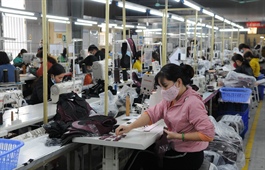Robust mechanisms required to conquer Russian textile market
Robust mechanisms required to conquer Russian textile market
With many advantages and an existing free trade agreement, Vietnam’s textile and garment exports to the $13-billion Russian market have big room for development, which could be further boosted by establishing joint ventures in the two nations.

Veselov Vitalievich, vice president of the Primorsk Chamber of Commerce and Industry of Russia, last week talked about the possibility of the establishment of more joint ventures in Vietnam’s textile and apparel industry.
“Vietnam is geographically close to the prosperous Northeast Asian countries of China, South Korea, and Japan, while holding a key position in the Eurasian transport corridor,” Vitalievich said.
“The opportunity for cooperation between businesses of the two countries is great,” he believed, “as the sea freight route connecting the Russian city of Vladivostok with Haiphong and Ho Chi Minh City has been put into operation since May, helping to trade goods between the two countries within only 9-12 days.”
The establishment of joint garment ventures seems also more relevant as some global clothing and footwear brands are withdrawing from the Russian market, as Andrey Pecherin, head of Economic Affairs at the Russian Trade Representative Office in Vietnam pointed out.
“Currently, many Russian enterprises are considering localising their production facilities in Vietnam,” added Pecherin. “Using Vietnam’s preferences and re-exporting its textile and garment products to ASEAN markets will be another opportunity for Russian businesses.”
Vietnam’s textile and garment industry has attracted $32.9 billion in registered foreign investments, but Russia had only eight projects with $22.9 million, according to the Vietnam Textile and Apparel Association (VITAS).
Before March of this year and the Russia-Ukraine conflict, Russia might have attracted the attention of textile enterprises, but now, they are not too interested.
VITAS president Truong Van Cam said, “The risks when exporting to Russia have gone beyond the capacity in settlement of enterprises in both people and goods.”
Cam added that textile manufacturers would require a “mechanism to ensure safety for people and goods when exporting textiles to the Russian market.”
He explained that a number of Vietnamese textile and garment enterprises were affected as soon as the conflict broke out.
“Currently, many orders have been completed but enterprises cannot ship their goods, leading to a slow collection of payments and sluggish production due to limited funds,” Cam explained.
The imposition of sanctions by the US and Western countries has tightened business with the Russian market.
Nguyen Van Thoi, chairman of garment producer TNG Investment and Trading JSC, said that his company’s orders have not been delivered to its partner in Russia, Sportmaster Group, as international shipping companies all “refused to ship to Russia”.
“Many banks are also unable to pay business contracts with the Russian market because the SWIFT international payment system has been disconnected from it,” Thoi said.
The lack of interest in the Russian market is resonant with existing problems, such as the regulation of export thresholds for textiles and garments in the free trade agreement (FTA) between Vietnam and the Eurasian Economic Union (EAEU), of which Russia is also a member. The agreement further includes Belarus, Kazakhstan, Armenia, and Kyrgyzstan and was signed in 2015 and came into force in 2016.
According to VITAS, another issue for Vietnam’s exporters is Russia’s low import threshold, which is based on an export growth rate of 150 per cent compared to the previous three years. Since these businesses cannot estimate the quantity of already exported textiles and garments to Russia, the risk is great that shipments that exceed the threshold become subject to high tax rates and, in many cases, cannot be delivered, without an option to recover the capital.
When Vietnam was negotiating the FTA with the EAEU, the export turnover of local textiles and garments to Russia was still low, at about $130 million in 2013 and $160 million in 2014.
In the first quarter of 2021 alone, however, Vietnam’s exports in the sector had already reached $65.6 million, according to the General Department of Customs.
The Russia-Ukraine conflict shows no sign of stopping, and many opportunities are being overshadowed by existing hurdles.
Duong Hoang Minh, trade counsellor of Vietnam in Russia, said, “The scale of the Russian textile and garment market has reached over $13 billion, which is almost equivalent to the South Korean market. Products exported from Vietnam to Russia are mainly from joint ventures between enterprises of the two countries or outsourced to international brands. These have grown quite a bit but still account for a small proportion of the market, only making up about 4.5 per cent in 2021.”





















